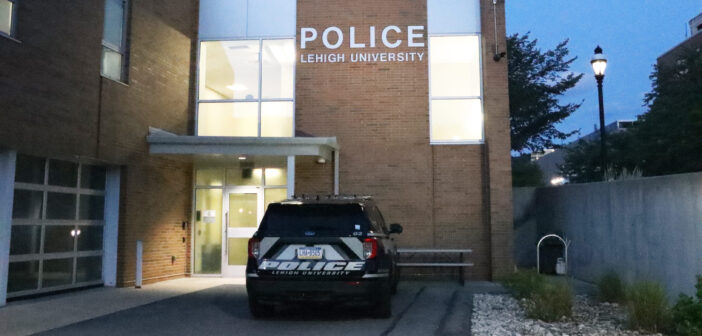Terrified students huddled under desks and sprinted between buildings as sirens wailed and Lehigh and Bethlehem police officers surrounded the Business Innovation Building.
Four months ago, Northampton County 911 for non-emergencies received a call that there was an active shooter at “the main building” at East Packer and Webster. A HawkWatch alert was sent out to the campus community, and active shooter protocols were enacted on Lehigh’s campus and in the surrounding area.
Updates were sent through HawkWatch to the campus community beginning at 9:44 p.m. until 10:51 p.m., when investigations revealed the call was a hoax. Referred to as swatting, false claims of imminent danger like this instill fear nationwide.
According to an FBI report, swatting involves calling 911 and faking an emergency that draws a response from law enforcement — usually a SWAT team.

Along with Bethlehem Police, LUPD responded to the active shooter threat on campus on May 7. Upon investigation, it was concluded the threat was a hoax. (Maeve Kelly/BW Staff)
Josh Fleitman is the campaign director for CeaseFirePA, an anti-gun violence organization working to hold lawmakers accountable, aid impacted communities, educate the public and bridge the gap between broad national groups and hyperfocused local anti-gun violence groups.
Fleitman said gun violence affects everyone, and there is a perpetual fear of school shootings nationwide, as false alarms trigger real emotions.
“It’s no longer a fantastical ‘this could never happen here’ kind of thing,” Fleitman said. “It’s gotten to the point where gun violence has touched so many people and is so real, that even just a false alarm can trigger trauma.”
Jason Schiffer, assistant vice president of campus safety and chief of Lehigh police, said his police department implemented a systematic approach of activating safety protocols, deploying officers and searching for the threat after the initial call was received, regarding the swatting incident at Lehigh in May.
Schiffer said the “Run, Hide, Fight” protocol, developed by the U.S. Department of Homeland Security, was immediately communicated to students, faculty and staff through HawkWatch.
He explained the first step is for individuals to clear the dangerous area, if possible, and hide in a barricaded or discreet place if someone cannot get away. If those two steps do not work, then “fighting” might be necessary.
Neave Murray, ‘25, was at the Alpha Phi sorority house during the swatting incident last spring.
She said the initial HawkWatch alert was scary, and all her friends were texting each other to check if everyone was safe. A few of her friends were in the Health, Science, and Technology building — situated a couple blocks away from where the active shooter was said to be located. They barricaded themselves into rooms within the building.
Murray experienced a school shooting when she was in high school, so she said she knew how to react.
“I kind of felt like I knew how to go through it because I’ve had so many drills and so many things because of that,” Murray said.
Police determined the threat to be a hoax less than an hour after the initial notifications to the campus community.
“It (was) immensely frustrating because there (was) just a complete lack of information,” Schiffer said. “And that causes confusion.”
When investigating a threat like this, Schiffer said the police department looks back at the phone call to see what information they can get from it, including caller ID or an IP address, and they run anything they find through the local database.
The Lehigh and Bethlehem Police Departments are trained to work in tandem during threats like the one last spring.
Lehigh Police Sargeant Kyle Fisher, who is in charge of training for the department, said they had a joint training with the City of Bethlehem Police and City of Bethlehem Fire and EMS on Lehigh’s Mountaintop Campus.
“That was known as Active Threats Integrated Response Training, where our police officers were trained how to handle a threat,” Fisher said. “But more importantly, how to interact with the emergency medical people in order to get them into the building to provide life-saving aid.”
Schiffer said swatting incidents are local and federal crimes, so local departments work with the FBI: the main investigating agency for these types of threats, with the necessary jurisdiction and resources.
According to an AP News report published in November 2022, “(FBI) officials have identified calls to about 250 colleges, 100 high schools and several junior high schools since early June falsely reporting explosive devices being planted at the schools or saying that a shooting was imminent.”
Fleitman said he has seen an increase in new swatting incidents.
“I think it is happening more and more often,” Fleitman said. “And I think it’s happening because these fraudsters know that they’re tapping into a legitimate, visceral fear.”
He said people shouldn’t have to live in a country or community where they don’t feel safe, and CeaseFirePA is currently focusing heavily on three legislative issues that generally address gun violence.
Presidential Policy Directive 8 is based on lessons learned from situations like terrorist attacks, hurricanes and incidents in academic institutions. It defines preparedness through five mission areas: Prevention, Protection, Mitigation, Response, and Recovery.
In response to this directive, the FBI published a guide for developing high-quality emergency operations plans for institutions of higher education in 2013, outlining how these institutions can take steps to plan for potential emergencies such as swatting or gun violence.
Fisher said LUPD and the Bethlehem Police Department are planning to host another Active Threats Integrated Response Training in October.
Continuous training and protocol development could help ensure emergency response departments are as prepared and well-equipped as possible to handle hoaxes and active threats on and near campus.
“Out of every bad situation, I’d like to think that we learn valuable lessons and we come out of it better equipped than we were before,” Schiffer said.






Comment policy
Comments posted to The Brown and White website are reviewed by a moderator before being approved. Incendiary speech or harassing language, including comments targeted at individuals, may be deemed unacceptable and not published. Spam and other soliciting will also be declined.
The Brown and White also reserves the right to not publish entirely anonymous comments.